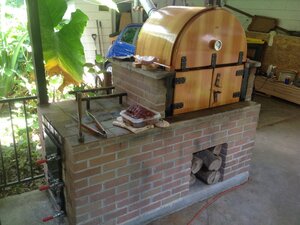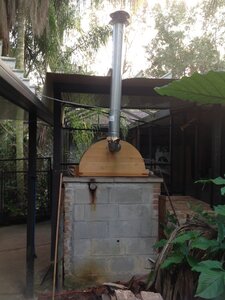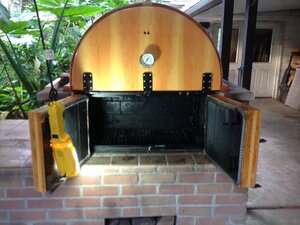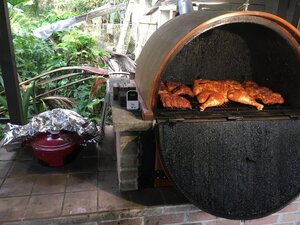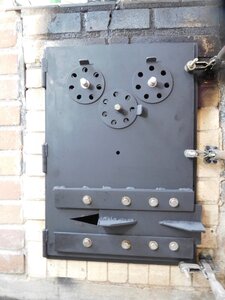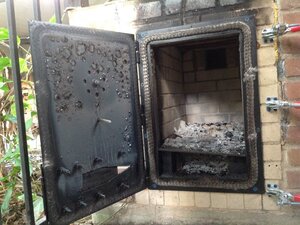I am contemplating a radial new approach (for me) to firebox fire management on my smoker.
I have a medium sized masonry smoker that I've used for the past 25 years or so. It is an offset design (fire box to the side of cook chamber). My method of building my fire has been to fill the fire box with wood (oak - because it is plentiful here in Central Florida). When I say fill the firebox, I mean fill it - front to back and top to bottom (less wood rack a couple inches off bottom). I usually place one big log to the side that takes up about half the box and fill the rest with smaller pieces. I start the fire with a propane burner stick for about ten minutes, then let the fire burn with open firebox door, then closed door with vent open, and then throttle down vent as temperature in cooking chamber increases to around 300 to 350, where I let it burn until the white smoke dies down. After about two hours, my fire is ready for meat. Smoke is moderate to low and after the first hour or two with meat on, the smoke will be thin and blue to almost nothing visible while maintaining a temp of 230 or so. Typically, my fire will last a good 7 or 8+ hours without adding any wood. If I'm doing a longer smoke, I pre-burn several sticks of wood in a separate burner, and then add the wood to the fire after burning for 20 minutes or so to avoid any thick white smoke.
Because of the large volume of wood in my firebox, intake vent management is critical to maintaining a constant cook chamber temperature. Although, once stable, my smoker really does keep fairly steady temperatures. Just the occasional nudge of the firebox vent is required.
I run my three-inch diameter chimney wide open. I've never tried to throttle it down - just never had a reason to try. I do have a damper on it.
Over the years I've often read about it being best to build small hot fires rather than a large cool fire. I've been building large cool (relatively) fires. I'm thinking that maybe that is not the best approach. I've recently watched several videos of side-burner smoker fire management and they all build a small bed of coals and add one or two SMALL sticks of wood as needed to maintain a small but hot fire. That should be fairly easy in my firebox as my firebox is rather long and narrow with the only door (with vent) being at one of the long ends of the firebox. I'm thinking to build my bed of coals in the rear half of the firebox and add one or two small splits as needed to maintain the small hot fire. I should also be able to place one or two small splits near the front part of the firebox without them catching fire for pre-heating.
Just curious what thoughts anyone might have to share. Thanks. Some pics attached.....






I have a medium sized masonry smoker that I've used for the past 25 years or so. It is an offset design (fire box to the side of cook chamber). My method of building my fire has been to fill the fire box with wood (oak - because it is plentiful here in Central Florida). When I say fill the firebox, I mean fill it - front to back and top to bottom (less wood rack a couple inches off bottom). I usually place one big log to the side that takes up about half the box and fill the rest with smaller pieces. I start the fire with a propane burner stick for about ten minutes, then let the fire burn with open firebox door, then closed door with vent open, and then throttle down vent as temperature in cooking chamber increases to around 300 to 350, where I let it burn until the white smoke dies down. After about two hours, my fire is ready for meat. Smoke is moderate to low and after the first hour or two with meat on, the smoke will be thin and blue to almost nothing visible while maintaining a temp of 230 or so. Typically, my fire will last a good 7 or 8+ hours without adding any wood. If I'm doing a longer smoke, I pre-burn several sticks of wood in a separate burner, and then add the wood to the fire after burning for 20 minutes or so to avoid any thick white smoke.
Because of the large volume of wood in my firebox, intake vent management is critical to maintaining a constant cook chamber temperature. Although, once stable, my smoker really does keep fairly steady temperatures. Just the occasional nudge of the firebox vent is required.
I run my three-inch diameter chimney wide open. I've never tried to throttle it down - just never had a reason to try. I do have a damper on it.
Over the years I've often read about it being best to build small hot fires rather than a large cool fire. I've been building large cool (relatively) fires. I'm thinking that maybe that is not the best approach. I've recently watched several videos of side-burner smoker fire management and they all build a small bed of coals and add one or two SMALL sticks of wood as needed to maintain a small but hot fire. That should be fairly easy in my firebox as my firebox is rather long and narrow with the only door (with vent) being at one of the long ends of the firebox. I'm thinking to build my bed of coals in the rear half of the firebox and add one or two small splits as needed to maintain the small hot fire. I should also be able to place one or two small splits near the front part of the firebox without them catching fire for pre-heating.
Just curious what thoughts anyone might have to share. Thanks. Some pics attached.....
